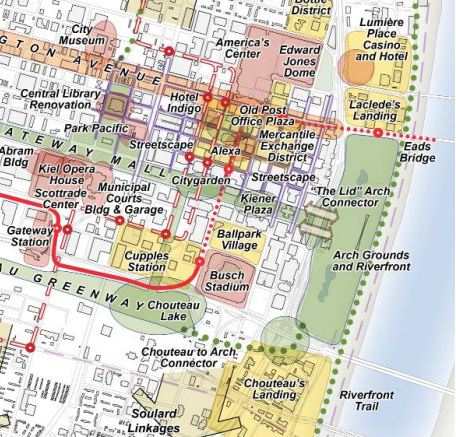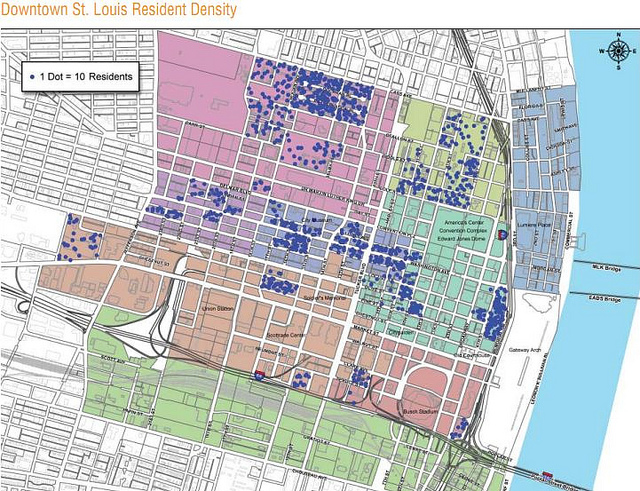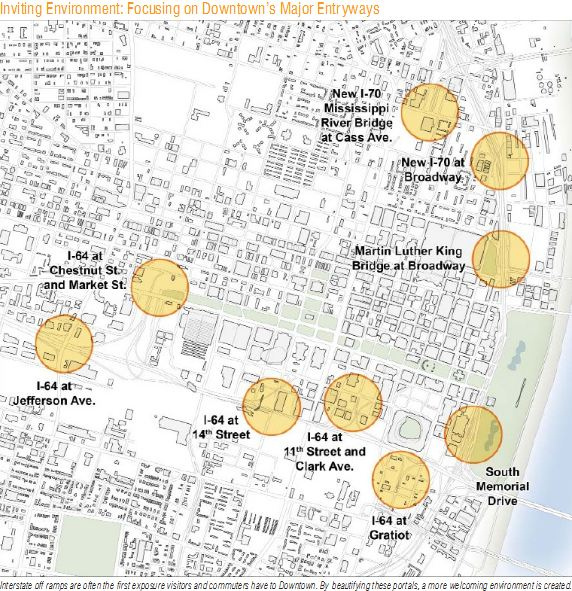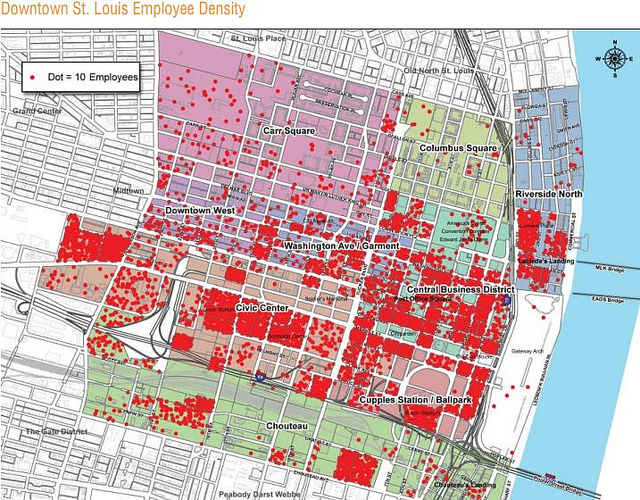 Downtown Next is the document that “continue[s] our resurgence and advances to the next stage of Downtown’s revitalization” – at least to the year 2020 – and follows on the prior Downtown Development Action Plan of 1999. Acknowledged in the plan is the fact that there are limited resources to address the opportunities. Downtown Next is supposed to be more “strategic than prescriptive”. That (and the fact that it calls itself a “Vision”) allows it to be more of an ‘up in the air’ document with somewhat little regard to practical implementation. It’s primarily an aspirational document. It’s good to have things like this to inspire the possible, even if what can be done inevitably falls short. Even then, it would seem that this plan doesn’t capitalize on its potential.
Downtown Next is the document that “continue[s] our resurgence and advances to the next stage of Downtown’s revitalization” – at least to the year 2020 – and follows on the prior Downtown Development Action Plan of 1999. Acknowledged in the plan is the fact that there are limited resources to address the opportunities. Downtown Next is supposed to be more “strategic than prescriptive”. That (and the fact that it calls itself a “Vision”) allows it to be more of an ‘up in the air’ document with somewhat little regard to practical implementation. It’s primarily an aspirational document. It’s good to have things like this to inspire the possible, even if what can be done inevitably falls short. Even then, it would seem that this plan doesn’t capitalize on its potential.
Downtown Next (DN) fails to understand the fundamental differences between a goal, objective, strategy, and implementation mechanisms at times. Goal 1 (p37) is for “A Thriving, dense residential network”, with the objective being a total population of 20,000 people by 2020. These are consistent with their headings. Under Strategy, the first item is ‘Add 5,000 residential units’. This is not a strategy. This is a goal or objective, and can even be a benchmark, or key result. Strategies around increasing the number of dwellings include but are not limited to lobbying the federal government for funding to improve local areas to encourage private sector development, advertising to the local market to live downtown, partnering with universities to add student housing within the downtown area, etc. Further, adding people by adding units is logical, but only if people want to live in them.

DN sometimes gives too little consideration to major issues. One objective and strategy refers to improving downtown entryways (gateways). Municipal gateways, particularly in ‘The Gateway City’ require far more thought and consideration than is given. The strategy should be to develop a gateways plan/strategy to ensure that the city knows what it wants for each major point of access into the city. An ad-hoc approach is unlikely to deliver on any key objectives the city may want.

Other times, it oversteps its role. A stated strategy is to ‘Give visitors a reason to explore Downtown’ is implemented by ‘Create visitor kiosks…’ (p23). This is really at a micro level and should be included within an implementation plan; and again, this is an action, not a strategy. Furthermore it is difficult to see the connection between this and the overlying objective ‘Active, walkable corridors’. Implementation actions are littered throughout the strategy, but none are actually included in the implementation section. These items should all be grouped together and placed in the implementation section. Not to mention, all goals, objectives, strategies, and implementation actions should be included in a table for easy reference.
Yet even considering DN is ‘more about theory than practice, it fails to address major issues affecting downtown, even at a cursory level. A look at the map purporting to show job density within the downtown area (p17) highlights the issue. Forgiving for a moment that Columbus Square, Carr Square, and Chouteau aren’t traditionally considered ‘Downtown’, the map shows distinct evidence that the downtown area has job ‘nodes’ and that there are major gaps in employment, particularly west of Tucker. The entire central ‘spine’ from Market street north to Olive St is virtually devoid of employment. The ‘Gateway Mall’ has a lot to do with this – eight consecutive city blocks of parkland within the CBD creates a dearth of activity in what should otherwise be a dense, lively centre. However, nowhere within the document is it considered that there should be jobs along this ‘spine’. Furthermore, there’s nothing in the strategy that addresses service or employment gaps. I appreciate this is not an economic report, but as a visioning document it should include at least a reference to addressing these issues.

The city also has potentially set itself up for failure with the strategy of ‘Compete…for large company relocations…”. St. Louis has gone down this path before and been unsuccessful and should avoid making similar mistakes. The goal of the city should be to improve internally. Being a place where people want to be will result in employers locating their offices. Spending time and money on major employers that may never pan out is not the best use of resources. The primary focus should be on capital improvements that the city desperately needs to improve its image, such as streetscape improvements and improving connections from Midtown and the Arch grounds to downtown.
The document, for all its maps (some of which are illegible in electronic format), doesn’t include a single reference to a primary ‘north/south’ connection. Washington Ave, the Gateway Mall, and Choteau Greenway are all acknowledged more or less as the major east/west connectors, and rightfully so. But where and what are the major north/south connections, and what are the goals for them? Logic would dictate that Broadway, 7th or 8th, Tucker, and 14th would all be candidates for elevation within the street hierarchy – however none are addressed. Going above that though, there is not a formal acknowledgement of a street hierarchy to begin with. It is difficult from a planning perspective to understand where the focus is of the community.
Within downtown there is a considerable lack of small retail space – 500sqf or smaller. The majority of spaces are considerably larger than 1,000 sq ft – at which the demands for both rent and parking rise exponentially. As the city tries to support small and micro-businesses, regain retail space and support walkability, it should support fine-grain spaces at ground level across the downtown area. This is an opportunity missed in Downtown Next.

There is much consensus among the planning community – and this is echoed in best practice across the world – that having surface parking is detrimental to an urban area. St. Louis has a glut of surface parking – and an oversupply of parking in general. There is some acknowledgement in DN that these surface lots need to be targeted for infill development (p41), However it is not an objective within itself. This should be a top priority for the City, and the fact that it is not indicates that there is a fundamental lack of understanding about critical downtown St. Louis issues. Existing buildings should not be demolished when there are countless surface lots available for development – nor should garages be constructed where there is considerable excess supply. DN does suggest implementation of a parking management plan – something long overdue – and it is hoped that parking rates as well as policy will be considered in this plan.
This not to say the DN plan is all bad. Generally, Downtown Next does a good job of providing a vision and direction for how the City of St. Louis wants to develop in the future. There are areas of bold vision, such as a Downtown Zone Overlay (p54), which if done correctly, can facilitate considerable change in the downtown area. And considering DN acknowledges over 70 contributors, the ability for it to be all things to all people was not impossible. However, it is this conspicuous lack of focus that holds back the potential of the document, and ultimately, the City.
Downtown Next – 2020 Vision for Downtown St. Louis
______________________
Sometimes derided for having planning documents gathering dust on a shelf, St. Louis may or may not have a profusion of development plans. But like proposals from developers, or retail openings and closings, it seems that a lack of action is worse than too much. Having plans is good, revising plans, proposing developments over and over again is better than the alternative, and likely reflects the vitality of ideas we seek. However, as a community we are lacking in the examination of these plans and proposals. Have you ever read a thorough critique of the Forest Park master plan? What about Midtown? Lafayette Square? Old North? nextSTL was the only place to find exhaustive exploration of the Arch grounds finalists designs. In that spirit, we hope to examine existing plans in St. Louis, beginning with Downtown Next.
– Alex, Editor
______________________
Dan is a Strategic Planner for the City of Greater Dandenong, a southeast suburb of Melbourne, Australia, where he is developing and implementing economic development strategies for local business districts. He is a graduate of MICDS in St. Louis and earned a BA in Urban Planning from the University of Illinois-Urbana/Champaign.


